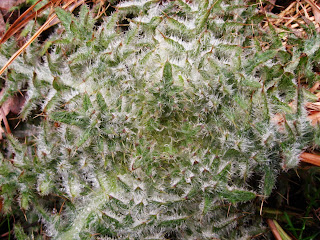I named my yoga class Earth Sky Yoga. There is an old Chinese creation myth called "Peng-gu kai tian" or "Peng-gu opens the Sky" (盤古開天)... once, a long time ago, before this Earth was born, or Sky, or any of the World as we know it today, there was nothing. One day, in the midst of nothing, there was born an Egg. In this primordial Egg slept a giant named Peng-gu. After many eons of sleeping, he finally started to stir, as his dreams shifted movement into his long slumbering limbs. As he moved, the Egg started cracking, and breaking. Finally, Peng-gu stood and stretched up, dividing the Egg in half. The top half became Sky. The bottom half became Earth. But, if Peng-gu released his arms or legs, then the Egg would close up again. So, he stood firmly between the two halves of the Egg, Sky and Earth, with his arms strongly upraised and his legs firmly rooted, and he stood. And he stood. And he stood... for such a long time, so many eons, he stood there, supporting and supported between Earth and Sky. Slowly, he got tired. One day, he finally fell down to the Earth. But he had stood there for such a long time that Sky and Earth, the two halves of the Egg, remained in place. Peng-gu's body became all the parts of our planet Earth as we know it... his Blood became the flowing Streams, Rivers, and Oceans. His bones became the Soil, Stones, and Mountains. His final Breath wooshed out into the Earth and breathed all the plants and animals into life. That breath continues to woosh and swirl around and through us, connecting us with all of life and each other, and with the primordial Great Mystery that brought Life into being.
When I stand in tadasana (mountain position with legs firmly rooted and arms relaxed downward), I feel like Peng-gu standing between Earth and Sky, supporting and being supported. As I extend my arms and raise my head up, I feel my plumb line of connection from the crown of my head, through my spine, and back down into Earth through the center of my feet. I am connecting, and I am connected.
Earth Sky Yoga.
Here's a brief outline of the eight limbs of yoga, ashtanga yoga. (Each limb builds on the next.)
1. yama (community code)- How do I interact with my community in a good way (5 parts)
- ahimsa (nonviolence/ compassion)- Living a life of unconditional service, and giving without expectation.
- satya (no lying/ truth)- Am I honest with myself and others in my thought, speech, and action?
- asteya (nonstealing)- Setting and observing clear boundaries.
- brahmacharya (abstinence/ chastity)- having integrity with all of my relationships.What is my relationship with my community as a whole? Individuals within my community? My relationship with my environment?
- aparigraha (noncoveting/ simplicity)- being satisfied with what I have, and willing to give. Keeping life simple, my thought, speech, and actions simple. Being in but not of, this world.
2. niyama (personal code)- How do I interact with myself and be the best human I can be (5 parts)
- sauca (purity)- Taking showers, eating well, thinking clearly, and speaking honestly.
- santosha (contentment)- Feeling and knowing the sweetness of life, regardless of life challenges.
- tapas (fire of self practice/ dedication)- Practice makes perfect. Practice, practice, practice! "Let your practice be the basis of your freedom."
- svadhyaya (self study)- Be as a question.
- isvarapranidhana (dedication to Creator)- Lokha samastha sukhini bhavantu- May all being be happy. We dedicate the fruits of our practice to all beings.
3. asana (movement practices)- The body is the doorway to the body-mind-spirit. During practice, maintain relaxed awareness and control over body, breath, and mind. Cultivating a strong and flexible body temple to house our Spirit.
4. pranayama (breath practices)- Breath is the line of connection between Earth and Sky, Body and Spirit. Body is the temple, Breath is the key.
5. pratyahara (sensory withdrawal)- Shut out, to tune in. How does sensory attunement dance with sensory withdrawal, through discernment, and choice making? Pratyahara reduces external stimuli to facilitate focusing on the internal environment of body, mind, and spirit.
6. dharana (concentration)- Our minds are like dirty wild elephants. First, you harness the elephant. Then, you tame the elephant. Slowly, it becomes cleaner. Then you ride it. Then it starts following you around. Dharana is the beginning of meditation, where we focus on one thing and that opens the door to everything else, which is true meditation, or dhyana.
7. dhyana (meditation)- Think of Gautama Buddha sitting under the bodhi tree for 49 days, and that little smile he has on his face.
8. samadhi (enlightenment/ self-realization)- The "purpose" of yoga is to attain samdahi, which is also called "moksha," or liberation. Liberation from the chains that we subonsciously wrap around ourselves, our self-limiting doubts, beliefs, and patterns of living our lives. True moksha, or liberation, and true samadhi, is not something that one strives for, but a state that one lives in, on a daily basis. Think of someone you know who is simultaneously full of child-like bliss (twinkly crinkly eyes filled with laughter), and elder wisdom (a certain depth behind every joke that sinks you deeper into the core of your own being, and your understanding of life.) You are samadhi already, returning to knowing your true nature.
--
~~~~~~~
Jiling . 林基玲
Jiling . 林基玲
. wild . creative . spirit
626.344.9140 / skype: Lin.JiLing













